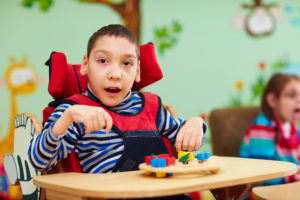Understanding Cerebral Palsy: Family Guide to Dyskinetic Cerebral Palsy in Oregon
Parents of a newborn will often look lovingly upon their child and wonder what their future has in store. They ask themselves the basic question, will our child enjoy a healthy and happy life? As the days and months unfold, parents may look forward to their infant reaching basic milestones, such as coordinated head movements at about three months of age, and back-to-tummy rolling at about six months. When these milestones and others are not reached, there is reason for concern. They might be stunned to receive a diagnosis of dyskinetic cerebral palsy from their infant’s pediatrician or neurologist. But what might have happened in their baby’s neurological development that could account for this loss? And when might it have happened? Could it have been prevented? If you believe that your baby’s diagnosis stemmed from a traumatic birth injury, then you should have our experienced Portland medical malpractice attorney review your case if you child was diagnosed with any type of cerebral palsy, especially dyskinetic cerebral palsy.
About 8,000 babies and infants are diagnosed cerebral palsy annually. Dyskinetic cerebral palsy is the second most common type of cerebral palsy, following spastic cerebral palsy but ahead of ataxic cerebral palsy. Mixed cerebral palsy means that someone is displaying symptoms of two of these three types of palsies. Dyskinetic cerebral palsy is further broken down to include three other types of palsies: athetoid, choreoathetoid, and dystonic cerebral palsies. These palsies each have specific symptoms and impairments that directly relate to the area of the brain that was damaged during a birth injury.
Depending upon the severity of the birth injury, dyskinetic cerebral palsy is associated with more than movement deficits, it also carries impairments such as mental retardation, language and speech problems, and problems with the lips, mouth and tongue. These impairments will not heal on their own, but with early intervention, symptoms may be managed depending upon their severity. For example, with early and proper intervention, a child may go from needing a wheelchair to needing a walker, making a big difference in their quality of life and level of independence.
Cerebral Palsy Defined
Very basically, cerebral palsy refers to several movement disorders in the brain. This could be because the movement centers in the brain were underdeveloped, or somehow sustained damaged. Because cerebral palsy is the term that covers multiple versions of movement disorders, we refer to it as an umbrella term. There are four different types of cerebral palsy, and the symptoms and impairments associated with each are different. Those four types of palsies are further defined by which area of the brain sustained damage, because certain sections of the brain are devoted to particular motor movements.
A young child or infant is diagnosed with one of the palsy types according to the geographical location in the part of the brain that suffered damage, and just how severe that damage was. Not all movements are controlled in the same part of the brain, and neurons take different message pathways within the brain to tell the infant which body parts to move. Those four categories are spastic cerebral palsy, dyskinetic cerebral palsy, ataxic cerebral palsy, and mixed cerebral palsy. Where the brain sustained birth injury, the seriousness of the birth injury, and the duration of the birth injury will determine if the child’s cerebral palsy will be described as mild, moderate, or severe.
Financial Costs of Cerebral Palsy
Just how much care your child may need throughout their lifetime depends upon the severity of the birth injury. The Centers for Disease Control estimate that lifetime care will be near $1.5 million for care (when adjusted for inflation). This care may involve a host of medical specialists at different times, including but not limited to neurologists, psychologists, nutritionists, rehabilitation and physical therapists, speech therapists, occupational therapists, and orthopedists, and a general practitioner or pediatrician to manage the whole team. Their goal is to increase your child’s independence and to optimize their physical and mental health.
How Common is Cerebral Palsy?
According to the Centers for Disease Control, about 1 in 323 children has been identified with one form of CP, making cerebral palsy the most common motor disability in childhood. A diagnosis of dyskinetic cerebral palsy is the second most prevalent form of the disease, following spastic cerebral palsy. Children demonstrate a wide variety of symptoms and impairments, depending upon the severity of their case, such as mobility issues, hearing and vision impairments, epilepsy, sleep issues, bladder and bowel control, and learning difficulties, intellectual disabilities, and communication issues, to name a few.
What Are the Main Causes or Risks Associated with Cerebral Palsy?
Cerebral palsy is caused when a part (or parts) of the brain that are responsible for both voluntary movements (such as walking) and involuntary movements (such as breathing) are damaged or underdeveloped.
There are three main movement centers in the brain responsible for a body’s movement. The first is the “motor cortex.” The motor cortex is in charge planning, controlling, and carrying out all voluntary movements, such as reaching for a toy. The second major part of the brain controlling movement is the “basal ganglia,” and the basal ganglia is basically clusters of neuron cell bodies, which tell the body when to start or when to prevent a movement. The basal ganglia also govern mood and behavior. The third major part of the brain controlling movement is the “cerebellum.” The cerebellum is the balance center, and it is responsible for voluntary movements like speech, balance, coordination and smooth muscle movements, and posture.
There are factors that may contribute to a child developing cerebral palsy, and those can be divided between “nature” and “nurture.” On the nature side, we have prenatal (activities happening in the womb) contributions such as genetic mutations, and infections like Rubella, Herpes Simplex 1 and 2, Syphilis, and Toxoplasmosis. Another item might be a malformed placenta that fails to deliver enough oxygen to the fetus, known as placental insufficiency. Multiple births, low birth weight, and prematurity can lead to cerebral palsy when the baby is delivered anytime before the 37th week mark, because the baby’s brain is still developing, including the parts of the brain that are responsible for voluntary and involuntary movements.
On the nurture side, there are perinatal (activities happening during the birthing process) situations that could contribute to the risk of developing cerebral palsy. This could include birth asphyxia or oxygen deprivation that lasts long enough during the birthing process to harm the brain. It is important for obstetricians and midwives to recognize and carefully monitor these situations so that they can recognize the best type of delivery for the mother and baby. Birth injury could also be the direct result of delivery trauma, where forceps or the vacuum extractor were used negligently or recklessly.
Cerebral palsy can also develop perinatally (activities immediately after birth or during the first few years). This can include head trauma due to accidents, and infections such as bacterial meningitis. Strokes and near drownings can also reduce oxygen to the brain damaging the movement centers
It is important to remember that many of these situations increase a person’s risk of developing cerebral palsy, and that these risks to not guarantee a diagnosis. Our Portland birth injury lawyer can review your case to determine if you have a strong case, and to preserve your rights and the rights of your child at no risk to yourself.
What are the Four Types of Cerebral Palsy?
There are four types of cerebral palsy that can be classified as spastic (or “stiff”) cerebral palsy, dyskinetic cerebral palsy, ataxic (“shaky”) cerebral palsy, and mixed cerebral palsy. These types of cerebral palsy all have different symptoms. Some of the most common symptoms associated with each time include the following:
- Spastic CP – this is the most common type of CP which results from damage to the motor cortex. The damage is caused by lesions which result in stiffness or rigidity throughout the body. This is due to hypertonia, or an abnormally increase in muscle growth which is larger and stronger, thus making joints and parts fo the body very stiff and painful to contract or move. There are three types of spastic CP, including one just affecting the legs, the entire body, or just one hemisphere. This causes a decrease in range of motion and makes walking, running, sitting down, and even laying down difficult, painful, and sometimes impossible.
- Dyskinetic CP – also known as dystonic, athetoid, or choreoathetoid CP, this type of cerebral palsy results from damage to the basal ganglia and cerebellum. This means that an individual may suffer involuntary and uncontrolled movements such as slow writhing, shaking, twisting, and otherwise curling motions—usually of the hands or feet. These symptoms can get worse during stress or excitement, and completely disappear when a person is sleeping. This type of CP can also result in hypotonia or a flaccid and loose muscle tone which is not strong or significant.
- Ataxic CP – this is the rarest of all types of Cerebral palsy and frequently results in involuntary twisting and shaking. The injury here is usually to the basil ganglia but largely the cerebellum which affects balance and coordination. This means that a child may have a difficult time grasping or gripping objects due to the shaking, as well as performing fine motor skills such as buttoning a shirt or writing. Some individuals ma also have a more difficult time swallowing or eating.
- Mixed CP – when two or more forms of cerebral palsy manifest themselves in a child, a child may have mixed CP. This is rare but also difficult because the needs of a child may constantly change from having super rigid muscle tone (spastic) to having super flaccid muscle tone (athetoid)—all which have a different way of responding.
A Closed Look at Dyskinetic Cerebral Palsy
This type of cerebral palsy is also known as dystonic CP, athetoid CP, and choreoathetoid CP, and is the second most prevalent form of the disease. About 20% of people with cerebral palsy fall into this category.(3)
When a child sustains a birth injury when their brain became oxygen deprived (during a stroke, for example) or other birth injury, then dyskinetic cerebral palsy may be the result. Someone suffering from dyskinetic cerebral palsy must endure involuntary and uncontrolled movements that they did not intend to make, such shaking, twisting, or slow writhing. During stressful times, or when someone is feeling anxious, such symptoms appear to intensify, however they seem to go away during periods of sleep.
Dystonia in General
The cause of dystonia CP is not known, although it is widely believed by researchers to be a result of damage to the basal ganglia that is genetic or is somehow otherwise acquired, such as a neonatal brain hemorrhage. Acquired dystonia could also be a result of a lack of oxygen to the baby’s brain, or another brain birth injury.
The basal ganglia process neurotransmitters help brain cells to communicate with each other in order to make a part of the body move. When the basal ganglia is underdeveloped or sustains birth injury, then this communication is interrupted and muscle movement is impaired. Depending upon the severity of the damage to the basal ganglia, symptoms can range between mild (blinking) to severe (eye spasms). Both eyes may begin to have an increase in blinking, and eventually the eye spasms may result in “functional blindness” meaning the eyes are healthy and capable of normal vision, but that the eye lids are closed. Other times, the neck muscles may pull the head forward or backward.
Generally, the longer an activity continues, then the greater the chance for symptoms to intensify and to become more noticeable. For example, someone may be able to hold a pen to sign a document, but they may have handwriting difficulties writing an entire letter. Often these symptoms will relax or disappear when the person is sleeping. Fortunately, dystonic CP is not characterized with trouble with understanding or thinking, although someone with this brain injury may become depressed and anxious.
So far there are no medications that can prevent dystonia CP, but there are some treatments that can manage the symptoms. These include Botulinum toxin, because small amounts can decrease muscle spasms associated with dystonia CP. Other medications are available that can block or regulate the effects of the neurotransmitter and reduce and control muscle movements, but these affect people differently and widely. Medications have side effects such as sleepiness, memory trouble, constipation, and dry mouth.
Athetosis (Athetoid) Part of Dyskinetic CP
Athetosis cerebral palsy is also known at athetoid CP. People with athetoid CP suffer from involuntary muscle movements with a wide spectrum of movement impairments.
Although the entire body may be affected, athetosis CP is characterized by the involuntary slow writhing of the hands and fingers, but sometimes the legs and toes as well. The muscle tone can fluctuate from being very stiff to being very floppy, making such activities as holding a pencil or drinking from a glass very difficult.
If the neck and facial muscles are affected, including the tongue, then drooling and saliva management will be necessary. This may make eating and drinking difficult for someone. Uncontrolled facial muscles may give a person a “grimacing” face. This also means that control of the lips or tongue may be impaired. Some people will experience breathing difficulty, and impaired speech.
Chorea part of Dyskinetic CP
This is known as choreathetoid cerebral palsy or just choera, depending on the symptoms. Chorea comes from the Greek word “dance.” Some of the involuntary random muscle movements that are associated with dyskinetic cerebral palsy are referred to as choreic because the person moves as if they were dancing. Other times the hands may move as if they were playing a piano. But unlike a repetitive choreographed dance, these brief movements are random and involuntary, and are not made deliberately in advance. The pace of the movement may also vary widely, from slow to fast. And the movements themselves could range from merely fidgeting to violent flailing.
If athetosis is also present, the patient may also display slow writhing and twisting. It is likely that they will have difficulty walking or with maintaining a solid posture, because these random movements will interrupt their progress. Chorea may also affect swallowing and speech, as the tongue may involuntarily stick out, making it very hard to eat or to speak.
Frequently Asked Questions
1) How long do I have to file a birth injury claim in Oregon if my child was diagnosed with Cerebral Palsy?
The time period to file a claim is called the statute of limitations period. This time period is really a time limit. This means that a claimant has a certain amount of time to file a claim otherwise the claim will be forever barred. If a victim who has a very serious type of cerebral palsy case misses the time limit, a court could automatically dismiss the case without even hearing the merits. This is why it is imperative to always ask a Portland birth injury lawyer and cerebral palsy lawyer on when you have to file a claim to protect your rights. These types of cases have a case-by-case time limit on them due to many different extensions (tolls) or shrinking of cases. Always ask what the time limit is for your case.
2) What could I recover for a cerebral palsy case in Oregon?
A party aggrieved by the medical negligence of a healthcare provider may commence a lawsuit and be entitled to “damages.” Under Oregon law, damages in a cerebral palsy birth injury case are typically monetary compensation for pain and suffering, medical bills, medication costs, future medical costs, future nursing needs, medical equipment, home or vehicle modifications, loss of enjoyment of life, loss of consortium, inability to ever work, and other related damages due to medical malpractice. Ask our Portland cerebral palsy lawyer for help with your case to learn what you may be entitled to.
3) How much is a cerebral palsy lawyer in Oregon?
Nothing upfront at Kuhlman Law! We accept most cases on a contingency fee agreement which means that we only get paid once we recover a settlement or court award for you. We also only get paid a percentage of what we recover for you, which means that you will not owe us any out-of-pocket expenses. We also pay in advance all of the court fees and expert expenses, and we only get reimbursed once we recover compensation for you.
Families with a Child Who Was Diagnosed with Dyskinetic Cerebral Palsy Should Ask Our Portland Birth Injury Lawyer for Help
If you or a loved one have been seriously injured or killed as a result of medical malpractice contact the Oregon Medical Malpractice Lawyers at Kuhlman Law at our number below or fill out the intake form. We offer a free initial case evaluation and handle cases on a contingency fee which means that you pay no money unless we recover.
Our law firm handles cases throughout the state including Bend and Portland Oregon, Redmond, Central Oregon, Sisters, Madras, Multnomah County, Deschutes County, Salem, Eugene, Corvallis, Lane County, Medford, Gresham, La Grande, Albany, Medford, Beaverton, Umatilla, Pendleton, Cottage Grove, Florence, Oregon City, Springfield, Keizer, Grants Pass, McMinnville, Tualatin, West Linn, Forest Grove, Wilsonville, Newberg, Roseburg, Lake Oswego, Klamath Falls, Happy Valley, Tigard, Ashland, Milwakie, Coos Bay, The Dalles, St. Helens, Sherwood, Central Point, Canby, Troutdale, Hermiston, Silverton, Hood River, Newport, Prineville, Astoria, Tillamook, Lincoln City, Hillsboro, and Vancouver, Washington.
We also have an office in Minneapolis, Minnesota and take medical malpractice cases throughout the Twin Cities, including St. Paul, Hennepin County, Ramsey County, Dakota County, Washington County, Anoka County, Scott County, Blaine, Stillwater, and Saint Paul Minnesota.




